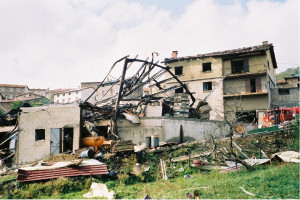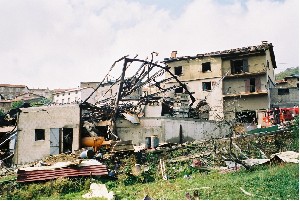Fire-fighters battled for 45 min to contain the blaze at a 1,000-m² hangar belonging to a fruit farmer when a very powerful explosion rocked the building around 5 pm. The explosive mass involved was estimated at 300-500 kg of TNT. The building housed: between 3 and 5 tonnes of ammonium nitrate stored in big bags, 2 gas bottles, and cold storage units filled with fruit. The emergency response plan was activated.
A total of 23 injured, including 18 fire-fighters, were reported, 9 of whom in serious condition. Roofs and cars were damaged over a radius extending 800 m by shockwave and projectiles, but no significant thermal effect was observed. The fire that spread after the explosion released a large quantity of black smoke. Emergency responders experienced difficulties: no mobile phone network coverage, fire hydrants plugged or lacking pressure. This accident was contained around 8 pm; 94 residents had to be housed elsewhere, after setting up a 300 to 400-m safety perimeter, and safety measures remained in effect throughout the night. The psychological team dispatched to the site as of 3 October logged over 100 consultations. Some 60 residents had to wait 4 days before returning home. The monitoring programme was stopped by local gendarmes 11 day after the explosion.
This explosion corresponded to the detonation of a portion of the 3 to 5 tonnes of ammonium nitrates present in the hangar. During the year 2003, local farmers’ fertiliser inventory levels were especially high since they went unused following a frost event in April. According to experts, the melted plastic from crates likely spread and got mixed with the ammonium nitrate, which in turn melted when exposed to heat. This mix might have been a factor leading to the instability that caused the explosion. Several ignition sources could have triggered the fire: an electrical overload on the installation (modified just prior in order to transform the cold storage rooms), or fermentation of the hay in storage or a simple smouldering cigarette, all of which have been hypothesised. Yet the most credible thesis would be that a light bulb apparently left lit exploded (the switch was found in the “on” position). The abundance of combustibles in the hangar led to a fast and extensive spreading of this fire.
Likely unaware of the hazards related to ammonium nitrate, the operator only notified the rescue crew of its presence at 8 pm. According to fire-fighter accounts however, no national memorandum had been circulated warning of the dangers associated with these fertilisers. Following this accident, verifications of storage conditions for ammonium nitrate-based fertilisers on farms and agricultural supply cooperatives were strengthened at the national level.
Download the detailed report in .pdf format (1.7 Mb)





